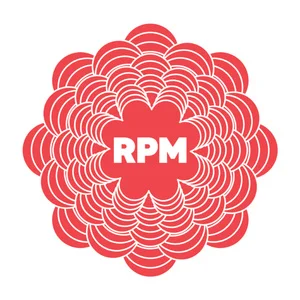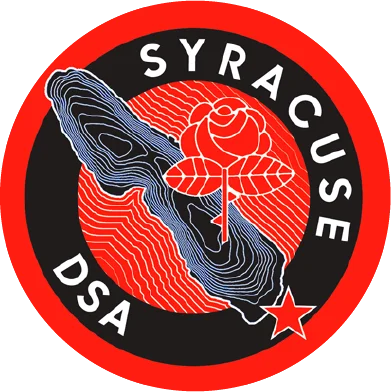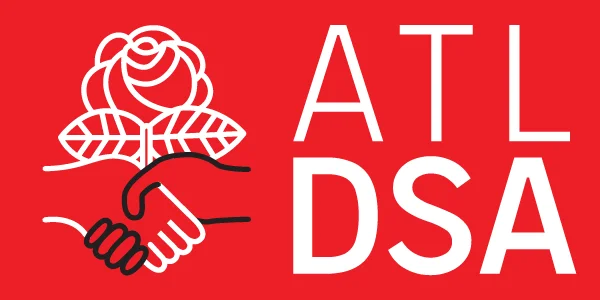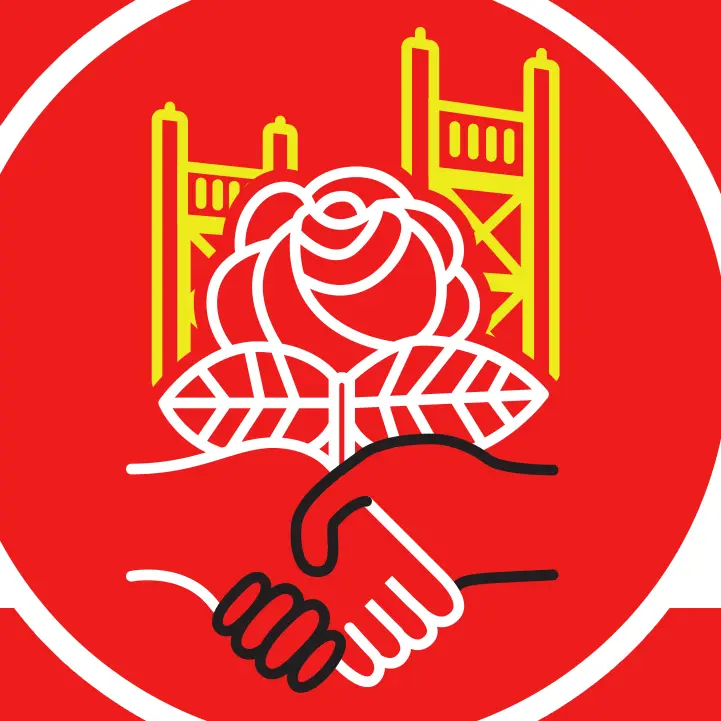

Columbus DSA Statement on the Murder of Donovan Lewis by Officer Ricky Anderson of the Columbus Division of Police
Donovan Lewis was a son, a brother, a sports fan, and a music-lover. He lived in Columbus surrounded by his family and friends. At 20 years old, his life was stolen from him by Officer Ricky Anderson in the early morning of Tuesday, August 30, 2022. While serving a warrant for his arrest, Anderson opened Mr. Lewis’s bedroom door and immediately fired his weapon, striking Lewis in the abdomen. Officers then handcuffed Donovan and carried him out onto the street. He was taken to the hospital and pronounced dead soon after.
Columbus DSA rejects the notion that there is any possibility the shooting was justified. Columbus Police Chief Elaine Bryant defended Anderson’s actions, saying that it appeared Lewis was raising an object in his hand at the moment police opened the door. In truth, a vape pen was the only object found on the bed after the shooting. Despite being a 30 year veteran of the force, Anderson did not hesitate even briefly before killing Donovan, opening fire in a split-second. Anderson had no opportunity to identify a weapon on Lewis’s person, nor did he afford Mr. Lewis an opportunity to surrender before ending the young man’s life. What the people of Columbus have witnessed—and what the released body camera footage demonstrates—is yet another murder in cold blood perpetrated by law enforcement against an unarmed Black person.
The murder of Donovan Lewis comes as the most recent in a series of local police killings of Black people, commonly young and/or unarmed. Columbus remembers the shooting of 16 year old Ma’Khia Bryant by Officer Nicholas Reardon, the murder of 23 year old Casey Goodson Jr. by Deputy Jason Meade, and the assassination of 47 year old Andre Hill by Officer Adam Coy. The Columbus Dispatch recently reported that of the 62 Columbus police shootings since 2018, 19 have been fatal, and of the 19 people killed, 12 have been Black. Time and time again, local law enforcement have demonstrated that they are unencumbered by any concern for Black life.
The Democratic Socialists of America remains an abolitionist organization, as does its Columbus chapter. We view the prison-industrial complex, including law enforcement agencies, as instruments of racial capitalism: the social and economic system governing American life. We believe that racial justice will not be possible until the white supremacist institutions of police and prisons are replaced by life-affirming alternatives. Columbus DSA reaffirms our commitment—shared with our comrades within and without DSA—to free America from the grip of mass incarceration. Together, we will build a society that respects human dignity irrespective of race and refuses to cage people as a solution to social problems. We will achieve food, housing, education, healthcare, and justice for the people of Columbus and beyond.
Justice for Donovan Lewis. Justice for Ma’Khia Bryant. Justice for Andre Hill. Justice for Casey Goodson Jr. Justice for all human beings who police officers have murdered and abused. Defund and abolish the Columbus Police Department

Teamsters Struggle for a Fair Contract at UPS


Debt Collective @ 9/8/22 General Meeting
The Debt Collective, a national union of debtors, will be joining our next GM, Thursday evening, 9/8, 7:00 p.m. at ArtRage Gallery (and online), to address debt and related topics like inflation! We’ll also be organizing for our 10/1 protest centered on housing and county budget priorities. We hope to see you there!
Check out our recording on our youtube channel here
The post Debt Collective @ 9/8/22 General Meeting appeared first on Syracuse DSA.

New York Is Ours: Election Day recap with Brandon West
Last Tuesday New York State held its second primary of the summer and New York City voters are sending another socialist senator to Albany. DSA endorsed candidate Kristen Gonzalez trounced Elizabeth Crowley winning the democratic primary in the newly formed Senate District 59, which includes portions of Queens, Brooklyn and Manhattan. We were at Kristen’s victory party in Long Island City and will share some sounds from the ground. And we are joined live tonight by former New York City Council candidate and NewsGuild of New York organizer, Brandon West. We’ll talk about the significance of Kristen’s win and the results of two other Brooklyn Senate races - Jabari Brisport’s run for re-election and David Alexis' challenge of Senator Kevin Parker in Flatbush.
Jack Devine also speaks with Nic, a fellow PSC union member, about the year ahead for thousands of teachers organizing for a more just CUNY.

Abortion is Freedom: Vote No Kansas and Right-wing Courts
Earlier this month, voters in the state of Kansas roundly rejected the so-called “Value them Both” measure, a proposed constitutional amendment that would have laid the groundwork for a complete abortion ban in the future. This measure, pushed by extremist anti-abortion lobbies, was defeated in a 59-41% result by the voters of Kansas. Tonight, we’re speaking to Melinda, an organizer with Lawrence DSA and chair of the PAC Vote No Kansas, and Dr. Russell Fox, professor of political science at Friends University in Wichita, on the organizing that successfully defeated this ballot measure. We will also hear from Alyssa, an organizer with Reproductive Justice Collective here in NYC, on the right-wing rise in the courts and the impact of groups like the Federalist Society.
Learn more about Lawrence DSA's successful campaign Vote No Kansas on Monday, August 29: https://actionnetwork.org/events/how-we-beat-kansas-anti-abortion-ballot-measure-a-campaign-debrief-w-lawrence-dsa
Follow Reproductive Justice Collective on Instagram at @reprojusticecollective.


Remembering Milt Tambor

Milt Tambor, a life-long democratic socialist and trade unionist and the founder of Atlanta DSA, died August 23 in Dunwoody, Georgia at age 84. Born in 1938 to a Jewish family on Manhattan’s Lower East Side, Milt was an active trade unionist and democratic socialist for over fifty years. He earned a Hebrew Teachers degree from Yeshiva University in 1957. Milt then went to Wayne State University in the heart of Detroit, Michigan where he completed his BA in Psychology. While working at the Jeffries Housing Project and Dodge Community House, where he fought against school and housing segregation in Detroit, Milt also earned a Master in Social Work degree at Wayne State.
After graduation, he stayed in Detroit to organize youth programming at the local Jewish Community Center. He then became Director of the UAW Retired Workers Center where he became involved in his staff union by volunteering on their local bargaining committee. In 1968 he became President of AFSCME Local 1640, a post he held for 10 years, during which he led a strike of 500 workers. During his years at Michigan AFSCME, Milt became a founding member of the Detroit New American Movement, and later joined DSA during the 1982 merger of NAM with the Democratic Socialist Organizing Committee. He then returned to Wayne State University and earned a PhD in Sociology in 1991, with a dissertation on bargaining with non-profit agencies.
After over 35 years with Michigan AFSCME, first as a local president and later as a staff representative and labor educator, Milt retired and moved to Atlanta with his wife Linda Lieberman. In 2006, as part of an effort to organize a fundraiser for Bernie Sanders’ senatorial campaign, Milt brought together local DSA members and progressives to establish the Metro Atlanta DSA. Over the next decade, he served as chair of our chapter through a wide variety of different campaigns and fights for democracy and equality. Whether it was opposing the Iraq War, supporting local labor unions, fighting foreclosures during the Great Recession, or marching for civil rights, Milt was always present and taking up a leading role. He was instrumental in rooting our organization in the workplace and community struggles of poor and working class Atlantans, using tactics from public education, to electoral organizing, to direct action.
Milt Tambor was a long-distance runner for Democratic Socialism. You can read more about Milt’s life and work in his memoir A Democratic Socialist’s Fifty Year Adventure or read the final chapter A History of Atlanta DSA. In addition to his wife, Linda, he is survived by his two sons, Alex and Jonah and a host of grandchildren and extended family. The funeral will be held at 4:30 pm this Friday, August 26th at Temple Sinai at 5645 Dupree Drive, Sandy Springs, GA 30327 if anyone wants to come to pay respects.


Gaza killing fields open and shut quickly: Why, and how to stop the carnage
August 25, 2022 04:54
By: David Mandel
Originally submitted to the Sacramento Bee, but was rejected.
The latest violence in Gaza [August 5-7] disappeared from headlines in record time, after “only” three days of heavy Israeli bombardment and in response, rocket fire from Gaza toward Israeli territory.
But even in that brief time, the damage wrought was overwhelming horrific. At least 49 Palestinians were killed, including 17 children, and hundreds wounded, according to the Palestinian Health Ministry. There were no serious Israeli casualties.
While some of the Gaza casualties were apparently caused by rockets that fell short, they would not have been launched if not for Israel’s self-described “pre-emptive strike,” itself a blatant violation of international law.
Beyond the immediate carnage, anyone who cares about the fate of Israelis, Palestinians and others affected in the region should not let this episode fade into the background, as has happened so many times before.
Since 2008, Israel has now waged five major assaults on the Gaza area, plus frequent additional attacks, killing nearly 4,000 people – one-quarter of them children – and destroying tens of thousands of homes and businesses. They previous ones lasted much longer before cease-fires were arranged, only to be broken again.
Why the outbreak this time, and why only three days? Analysts, citing formal and informal statements by the parties, have proffered several reasons:
- A flexing of military muscle by Israel’s leaders is a common pre-election tactic to solidify support among hawkish Israeli voters. Interim Prime Minister Yair Lapid is gearing up toward a Nov. 1 contest, for the fifth time in four years pitting the loyalists of former premier Binyamin Netanyahu against a diverse, shifting and also mostly hawkish coalition, united only around its opposition to him.
- But Israelis also have a habit of disaffection from the inconveniences posed by lengthier wars. So the quick cease-fire too was likely seen as an electoral asset.
- With fuel supplies cut off by Israel along with other crucial goods, shutting Gaza’s only power plant amid a heat wave and no clean water, failure to stop fighting would have downgraded conditions from hellish to doubly deadly, making Israel look bad.
- At least some elements of the international community may be losing patience with repeated bloody episodes of Israeli attacks on the Gaza fish barrel, so the short “mowing of the lawn,” as Israeli leaders have referred to their periodic initiatives, may have been meant to avoid further alienation, with short memories conveniently taxed by Ukraine, Taiwan and other current global flashpoints as well as domestic situations.
- Hamas, the ruling party in Gaza, abstained from joining the fray. Had the exchanges continued, it might have felt obligated to join in. So by halting the assault, Israel maintained political divisions among Palestinians along with its de facto arrangements with Hamas for slight easing of life for Gazans.
Nevertheless, the situation remains dire for Gaza’s 2 million-plus inhabitants, most of them descendants of refugees forced from their homes during Israel’s establishment in 1948. Israel and Egypt continue to impose full closure on the territory, with minimal – and fluctuating – exceptions to head off mass catastrophe. Health, nutrition, livelihood are all precarious.
Meanwhile, in various parts of the occupied West Bank, 2022 has seen a steady uptick in land takeovers with expulsions of Palestinians, city dwellers and rural farmers alike. These are invariably accompanied by brazen settler violence, abetted by the military, and by further crackdowns on any semblance of political resistance. The recent visit by President Biden underscored the utter lack of a diplomatic horizon.
The latest attack’s brevity seems to have been mostly successful in eliciting the desired response in Washington: many senators and representatives (“progressives” among them) had no comment at all, leading some optimists to conclude that they refrained from cheering for Israel when unlike in other rounds, there was no doubt this time about “who started it.” But almost all of those who did speak up mouthed the usual reflexive phrases about Israel’s “right to defend itself,” no matter how hollow it echoed.
It’s a nearly sure bet that the latest round will spawn calls in Congress for additional funding for Israel’s Iron Dome anti-rocket batteries (of dubious value, according to some experts) and other arms. Suddenly, Ukraine has supplanted Israel as by far the largest “beneficiary” of such transfers of our tax dollars to the U.S. arms industry via the ever-expanding “defense” budget.
When will we conclude that it’s time to devote our scarce resources instead to human needs at home and globally, and to planetary survival?
For starters, let’s stop pretending that the vast majority of us benefit from U.S. support of regimes that occupy their neighbors and repress democracy, including Israel.

Back to School

Fund, Fix, and Free the T! Boston DSA statement on T closure

Today, in an unprecedented and historic move, Governor Charlie Baker’s MBTA will shut down the entire Orange Line for thirty days of emergency maintenance. This, the severs a vital transit artery for hundreds of thousands of greater Boston residents, and forces riders to pay the price for decades of disinvestment from public transportation by corrupt politicians from both parties. The T closure will snarl traffic, cut people off from whole neighborhoods, make it more difficult to get to work, and take away time that people can spend with their families.
The Boston chapter of the Democratic Socialists of America condemns the Massachusetts political establishment’s abandonment of the T. We stand in solidarity with our neighbors and fellow commuters, the riders and frontline T workers who will bear the brunt of this crisis.

The T is falling apart. For the past decade, delays, derailments, service cuts, garages collapsing, unstable tunnels, leaking cars, rusted-out stairways, fires in tunnels and across bridges, and tragic and preventable deaths have undermined trust in the political institutions that are tasked with managing it for the public good. This doesn’t have to be the case – the T once stood as a point of pride for the city and its residents, a symbol of progress, and we must work to get there again.
Yet the collapse of the T was not caused by mere governmental incompetence, or an inevitable failure of public institutions. It’s the result of years of hard work by politicians like Charlie Baker and leaders in the Massachusetts legislature to undermine those public institutions. We condemn the failure of elected leadership and their abandonment of the public good that is mass public transit. We appreciate the legislature’s $400 million appropriation for the T in a recent transportation bond bill, although bond bills still leave a lot of the power in the hands of the Governor whether the money is even spent. We call for this full amount to be appropriated as fast as possible. But this is not enough. The T’s debt exceeds $8 billion, requiring a serious commitment to long-term funding from the state.
We call:
- For the legislature to come back into session to forgive the T’s unjust, inherited debt and create a dedicated, long-term sustainable source of funding for the T.
- In solidarity with Senator Markey, Representative Pressley, and others, for Governor Baker to make the MBTA’s entire system free during the Orange and Green Line extension shutdowns.
- For cities along the Orange and Green Line shuttle routes to install temporary protected bus and bike lanes so that commuters and residents utilizing alternate modes of transportation can travel safely, as we know the streets are not completely safe for non-car uses without these measures.
- For Maura Healey, the presumptive next Governor of Massachusetts, to resist attempts to privatize the T and undermine its unionized workforce, who work every day to protect commuters and deliver a public good, and to appoint a Secretary of Transportation with experience.
- For voters to vote yes on 1, the Fair Share amendment, this November to fund the T in a more comprehensive way.
- For DSA members and interested readers, to join us in canvassing at Haymarket station TODAY at 5 pm to circulate these calls to action with commuters!
Resist privatization! Fund, Fix, and Free the T!
Boston DSA is the local chapter of the Democratic Socialists of America for the Greater Boston area. We are an activist organization — not a political party — that works against oppression in its many forms. DSA’s members are building mass movements for social change while establishing an openly socialist presence in communities and politics in the Greater Boston Area, from the South Shore to the Merrimack Valley


TAMPA CITY COUNCIL TO VOTE ON TDSA’S CITY RESOLUTION ON ABORTION DECRIMINALIZATION

TAMPA, FL —
The Tampa chapter of the Democratic Socialists of America (DSA) has drafted a City Council resolution outlining support for decriminalizing abortion city-wide. This resolution has been drafted in collaboration with Councilwoman Lynn Hurtak in response to the recent overturning of Roe v Wade, and was presented to the Tampa City Council for a vote at the City Council meeting on August 4th, 2022. The City Council moved to table this vote until the evening City Council meeting on August 18th, 2022, with only Councilwoman Lynn Hurtak voting against delaying a vote. As a non-binding statement of intent, this resolution is the bare minimum that the Tampa City Council can do to show support for our reproductive rights and bodily autonomy.
This resolution outlines that the City Council of the City of Tampa:
- will not approve funding for actions or activities that would criminalize the rights of Tampa residents to make reproductive health decisions, including abortion, for themselves
- will not approve funding for any organization or entity operating a “crisis pregnancy center” or “pregnancy resource center” established with the purpose of opposing legal abortion and dissuading pregnant people from seeking abortion services
- will do everything in their power to make the criminalization of abortion the absolute lowest priority for city resources and personnel and approve a city budget that reflects as much
See the resolution attached in this email.
This resolution builds off a list of demands Tampa DSA has released for the City of Tampa regarding abortion rights, which has been signed by 223 community members and organizations. You can find and sign onto our list of demands here.
This resolution also mirrors a recent city resolution which passed in Austin, Texas to support decriminalizing abortion – the GRACE Act, or Guarding the Right to Abortion Care for Everyone Act. This resolution passed 10-1.
“This is the bare minimum Tampa’s City Council can do to show they oppose criminalizing our right to abortion care. In this unprecedented moment we need to challenge what’s clearly unsettled law and fight for our basic rights before they’re viciously stripped away. To not pass the full text of the proposed resolution would signal that Tampa’s City Council is unwilling to confront unconstitutional Tallahassee laws and any future abortion restrictions or bans that come our way. I hope they follow Councilwoman Hurtak’s lead and vote to pass this on the 18th.” – Jocelyn Koenig, member of Tampa DSA.
Tampa DSA is an official chapter of the Democratic Socialists of America. We believe that both the economy and society should be run democratically to meet human needs, not to make profits for the wealthy elite. We are a political and activist organization, not a party. DSA members use a variety of tactics, from legislative to direct action, to fight for reforms that empower working people. We have over 270 dues-paying members of our chapter.
Tampa Democratic Socialists of America (DSA) | Tampa, Florida | healthjustice.tdsa@gmail.com | tampadsa.org | https://www.facebook.com/tampadsa
The post TAMPA CITY COUNCIL TO VOTE ON TDSA’S CITY RESOLUTION ON ABORTION DECRIMINALIZATION appeared first on Tampa DSA.